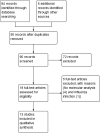Molecular mechanisms for understanding the association between TMPRSS2 and beta coronaviruses SARS-CoV-2, SARS-CoV and MERS-CoV infection: scoping review
- PMID: 34953136
- PMCID: PMC8709906
- DOI: 10.1007/s00203-021-02727-3
Molecular mechanisms for understanding the association between TMPRSS2 and beta coronaviruses SARS-CoV-2, SARS-CoV and MERS-CoV infection: scoping review
Abstract
The aim of this scoping review was to identify knowledge gaps and to describe the current state of the research on the association between TMPRSS2 and the essential beta coronaviruses (Beta-CoVs) infection and the molecular mechanisms for this association. We searched MEDLINE (OVID), EMBASE, and the Cochrane Central Register of Controlled Trials (CENTRAL). We included 13 studies. Evidence shows an essential role of TMPRSS2 in Spike protein activation, entry, and spread into host cells. Co-expression of TMPRSS2 with cell surface receptors (ACE2 or DPP4) increased virus entry. This serine protease is involved in the formation of large syncytia between infected cells. TMPRSS2 cleaved the Spike protein of SARS-CoV, SARS-CoV-2, and MERS-CoV, and increased virus propagation. Accumulating evidence suggests that TMPRSS2 is an essential protease for virus replication. We highlighted its critical molecular role in membrane fusion and the impact in viral mRNA replication, then promoting/driving pathogenesis and resistance.
Keywords: Betacoronavirus; Gene; MERS-CoV; SARS-CoV; SARS-CoV-2; TMPRSS2.
© 2021. The Author(s), under exclusive licence to Springer-Verlag GmbH Germany, part of Springer Nature.
Conflict of interest statement
The authors have no conflict of interest.
Similar articles
-
TMPRSS2 Contributes to Virus Spread and Immunopathology in the Airways of Murine Models after Coronavirus Infection.J Virol. 2019 Mar 5;93(6):e01815-18. doi: 10.1128/JVI.01815-18. Print 2019 Mar 15. J Virol. 2019. PMID: 30626688 Free PMC article.
-
SARS-CoV-2 and SARS-CoV Spike-Mediated Cell-Cell Fusion Differ in Their Requirements for Receptor Expression and Proteolytic Activation.J Virol. 2021 Apr 12;95(9):e00002-21. doi: 10.1128/JVI.00002-21. Print 2021 Apr 12. J Virol. 2021. PMID: 33608407 Free PMC article.
-
The TMPRSS2 Inhibitor Nafamostat Reduces SARS-CoV-2 Pulmonary Infection in Mouse Models of COVID-19.mBio. 2021 Aug 31;12(4):e0097021. doi: 10.1128/mBio.00970-21. Epub 2021 Aug 3. mBio. 2021. PMID: 34340553 Free PMC article.
-
Covid-19 pathogenesis in prostatic cancer and TMPRSS2-ERG regulatory genetic pathway.Infect Genet Evol. 2021 Mar;88:104669. doi: 10.1016/j.meegid.2020.104669. Epub 2020 Dec 7. Infect Genet Evol. 2021. PMID: 33301988 Free PMC article. Review.
-
Spiking dependence of SARS-CoV-2 pathogenicity on TMPRSS2.J Med Virol. 2021 Jul;93(7):4205-4218. doi: 10.1002/jmv.26911. Epub 2021 Mar 18. J Med Virol. 2021. PMID: 33638460 Free PMC article. Review.
Cited by
-
DNA and RNA vaccines against tuberculosis: a scoping review of human and animal studies.Front Immunol. 2024 Oct 3;15:1457327. doi: 10.3389/fimmu.2024.1457327. eCollection 2024. Front Immunol. 2024. PMID: 39421744 Free PMC article. Review.
-
In Silico Screening of Novel TMPRSS2 Inhibitors for Treatment of COVID-19.Molecules. 2022 Jun 30;27(13):4210. doi: 10.3390/molecules27134210. Molecules. 2022. PMID: 35807455 Free PMC article.
-
Human Cell Organelles in SARS-CoV-2 Infection: An Up-to-Date Overview.Viruses. 2022 May 19;14(5):1092. doi: 10.3390/v14051092. Viruses. 2022. PMID: 35632833 Free PMC article. Review.
References
Publication types
MeSH terms
Substances
LinkOut - more resources
Full Text Sources
Medical
Miscellaneous


